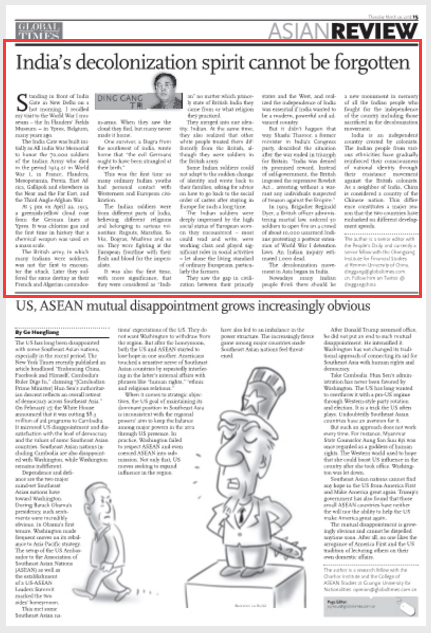Major Power Relations
Your Present Location: PROGRAMS> Major Power RelationsDing Gang: India’s decolonization spirit cannot be forgotten
By Ding Gang Source: Global Times Published: 2018-3-28
Standing in front of India Gate in New Delhi on a hot morning, I recalled my visit to the World War I museum - the In Flanders` Fields Museum - in Ypres, Belgium, many years ago.

The India Gate was built initially as All India War Memorial to honor the 70,000 soldiers of the Indian Army who died in the period 1914-21 in World War I, in France, Flanders, Mesopotamia, Persia, East Africa, Gallipoli and elsewhere in the Near and the Far East, and the Third Anglo-Afghan War.
At 5 pm on April 22, 1915, a greenish-yellow cloud rose from the German lines at Ypres. It was chlorine gas and the first time in history that a chemical weapon was used on a mass scale.
The British army, in which many Indians were soldiers, was not the first to encounter the attack. Later they suffered the same destiny as their French and Algerian comrades-in-arms. When they saw the cloud they fled, but many never made it home.
One survivor, a Dogra from the southwest of India, wrote home that "the evil Germans ought to have been strangled at their birth."
This was the first time so many ordinary Indian youths had personal contact with Westerners and European civilization.
The Indian soldiers were from different parts of India, believing different religions and belonging to various minorities: Rajputs, Marathis, Sihks, Dogras, Muslims and so on. They were fighting at the European frontline with their flesh and blood for the imperialists.
It was also the first time, with more significance, that they were considered as "Indian" no matter which princely state of British India they came from or what religion they practiced.
They merged into one identity: Indian. At the same time, they also realized that other white people treated them differently from the British, although they were soldiers in the British army.
Some Indian soldiers could not adapt to the sudden change of identity and wrote back to their families, asking for advice on how to go back to the social order of castes after staying in Europe for such a long time.
The Indian soldiers were deeply impressed by the high social status of European women they encountered - most could read and write, were working class and played significant roles in social activities - let alone the living standard of ordinary Europeans, particularly the farmers.
They saw the gap in civilization between their princely states and the West, and realized the independence of India was essential if India wanted to be a modern, powerful and advanced country.
But it didn`t happen that way. Shashi Tharoor, a former minister in India`s Congress party, described the situation after the war ended in triumph for Britain. "India was denied its promised reward. Instead of self-government, the British imposed the repressive Rowlatt Act... arresting without a warrant any individuals suspected of treason against the Empire."
In 1919, Brigadier Reginald Dyer, a British officer administering martial law, ordered 50 soldiers to open fire on a crowd of about 10,000 unarmed Indians protesting a postwar extension of World War I detention laws. An Indian inquiry estimated 1,000 dead.
The decolonization movement in Asia began in India.
Nowadays many Indian people think there should be a new monument in memory of all the Indian people who fought for the independence of the country including those sacrificed in the decolonization movement.
India is an independent country created by colonists. The Indian people from various ethnicities have gradually reinforced their consciousness of national identity through their resistance movement against the British colonists. As a neighbor of India, China is considered a country of the Chinese nation. This difference constitutes a major reason that the two countries have embarked on different development speeds.
The author is a senior fellow with the Chongyang Institute for Financial Studies at Renmin University of China.
Key Words: India; World War I; British; Ding Gang























































































 京公网安备 11010802037854号
京公网安备 11010802037854号





